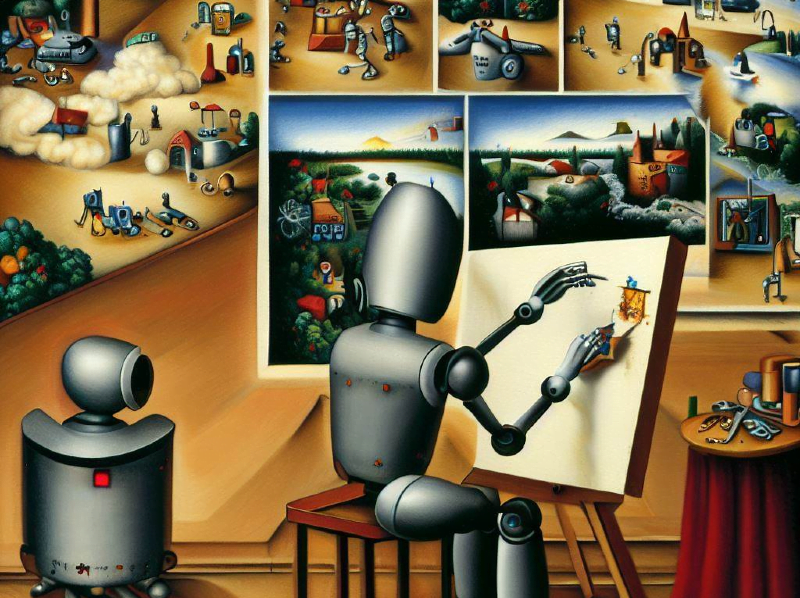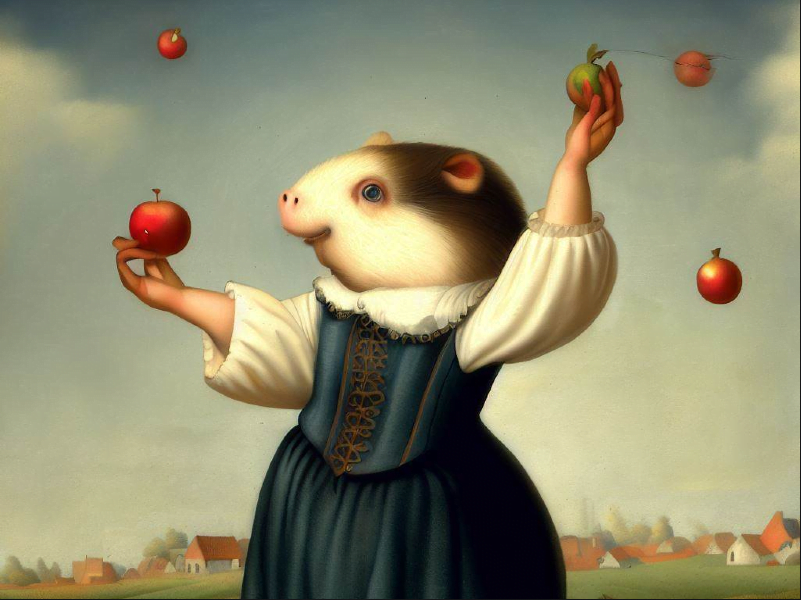Well, hello again my tech potatoes! Welcome to another eye-opening exploration in the ever-changing universe of innovation. Today, we’re about to embark on a deep dive into the mesmerizing ocean of artificial intelligence (AI), specifically the dazzling world of generative image AI and how it’s leaving indelible footprints on the sands of the web and graphic design industry. So, pop that tea bag into your steaming mug, ensconce yourself in that snug chair of yours, and get set for another juicy byte of tech nirvana.
Let’s kick off our journey with the superstar of the day, DALL·E 2. This isn’t just another AI on the block, folks! This brainchild of the ingenious team at OpenAI is capable of churning out unique, jaw-droppingly realistic images from a mere text description. And it doesn’t stop at that! It can stretch images beyond their original confines and tweak existing visuals with a level of realism that’s nothing short of breathtaking.

Still not wowed? Well, get this. DALL·E 2 can whip up a smorgasbord of variations of an image, each one a unique spin on the original. It’s an eye-popping spectacle, to say the least! Now in its beta phase, this system has a potential range of applications that’s mind-bogglingly vast. So, if you want to hear about the riotous time I’ve had churning out guinea pig pictures over the last few weekends, stick around as we delve into the nitty-gritty of how this bad boy operates and the seismic impact it could have on web and graphic design.
Under the Veil: The Mechanics
Like its predecessor, the original DALL·E, this shiny new model runs on GPT-3. For the uninitiated, GPT-3 is an autoregressive language model boasting a staggering 175 billion parameters. Yep, that’s billion with a B – a much higher number than my public-school education got me to in Tasmania. That’s a staggering ten times more than any other language model out there. It’s a powerhouse, to say the least.
DALL·E 2 leverages a cool technique dubbed Contrastive Language-Image Pre-Training or CLIP for short. This allows it to match text descriptions with images based on text-image pairs. It’s like having a robot pal that knows exactly what you’re thinking and can find an image to match. Spooky, but in a cool way, right?
But the intrigue doesn’t stop there. The system converts these pairs into a “prior”. A generator, known as a “decoder”, then takes this prior and whips up new variations of the image that better sync with the text command. The outcome? A final image that’s uncannily akin to the concept your text was trying to portray. It’s practically Illuminati magic!
However, DALL·E 2 isn’t a one-trick wonder. It can also expand images beyond the original canvas, conjuring up expansive new compositions. And it’s not just about crafting new images. It can make incredibly realistic edits to existing images, all from a natural language caption.
This includes adding or removing elements in the image while taking into account minute details like shadows, reflections, and textures. And if you’ve got an image in mind already, DALL·E 2 can create a whole array of variations inspired by your original, making it an absolute godsend for content creators, bloggers, and writers.
And for those of you worried about potential misuse, rest easy. OpenAI has put some thought into this. They’ve limited the ability of DALL·E 2 to generate violent, hate, or adult images and have put safeguards in place to prevent misuse. So, it’s not just smart, it’s also responsible (but not perfect, of course).
The New World Order: Impact on Graphic and Web Design
All this sounds magical, right? (And, let’s be honest, kinda like something ripped straight out of a Harry Potter book.) But how does this revolutionize professions traditionally driven by humans, like web and graphic design? Well, imagine having a personal graphic designer at your beck and call, except you’re communicating with a state-of-the-art AI model. Need a “pink elephant sporting a lopsided red bowling hat”? DALL·E 2 can whip that up in a jiffy, with plenty of room for tweaks and adjustments.
Designers can now take a snapshot of a garment and, using AI tools like DALL·E 2, place it on a model that doesn’t even exist in real life. It’s a game-changer for advertising and marketing products. And there’s more! Other AI tools, such as Remover.AI, lend a helping hand to designers by enabling them to swiftly and accurately erase anything unwanted from images.
But that’s not all. Generative image AI like DALL·E 2 and Midjourney can cook up entire page layouts. While web designers still have to do the coding, AI technology is taking over one of the most time-consuming aspects of web design: envisioning the page layout. The process is straightforward, and the results can be mind-blowingly accurate.
Does this mean we no longer need human designers? Well, it’s not that cut-and-dry. AI programs like DALL·E 2 are built to assist, not replace. They empower designers to churn out a high volume of illustrations in a short span of time, but the creative vision and final stamp of approval still rest with the human designer.
Now, you might be wondering about the ethics of using AI in advertising, particularly when it comes to AI-generated images of products. This is where we need to tread with caution. AI-based tools like DALL·E 2 can create images of products that don’t exist or differ from their real-life counterparts. This could set up unrealistic expectations for consumers and potentially lead to disappointment or even accusations of false advertising.
As we continue to explore the potential of AI in design, it’s critical to have ongoing discussions about the ethical implications. AI technology, like DALL·E 2, comes with safety mitigations to prevent harmful generations and has a content policy in place to curb misuse. However, we must remember that the use of AI, particularly in areas like advertising, must be guided by principles of honesty, transparency, and respect for consumer rights.
Final Thoughts
The potential of generative image AI like DALL·E 2 is as limitless as the universe itself. We’re not just talking about conjuring up images of mythical creatures or creating dazzling variations of existing visuals. We’re looking at a future where the line between imagination and reality becomes deliciously blurred, where the barrier between what’s possible and impossible is torn down, brick by brick.
Want to visualize the Mona Lisa if she were a potato form Tasmania? DALL·E 2 can paint you a picture. Need a picture of a guineapig juggling apples? Consider it done. Want to see how it would look to see Alice Cooper drink a cup of tea with the Queen of England? Well, you get the idea. Moreover, the impact of generative image AI extends far beyond just graphic and web design. Think product design, architecture, fashion, filmmaking, and much more. The possibilities are virtually endless.

However, it’s not all rosy. As we chart a path towards a future teeming with AI, we also need to navigate the tricky waters of legal, ethical, and societal implications. Who owns the copyright to an image created by AI? How do we prevent the spread of deepfakes and misinformation? How do we ensure that AI is used for the greater good and not for nefarious purposes?
These are questions that we, as a society, need to grapple with as we move forward. It’s a delicate balancing act between leveraging the immense potential of AI and ensuring that we don’t lose our moral compass in the process.
At the end of the day, generative image AI like DALL·E 2 isn’t just a technological marvel. It’s a testament to human ingenuity and creativity, a symbol of our relentless quest for innovation. As we continue to unlock the full potential of this technology, let’s remember to wield it responsibly. Let’s use it to create, inspire, and make the world a better place, one image at a time.
So, as you finish that cup of tea and contemplate this brave new world of AI, remember this: the future is here, and it’s as exciting as it is challenging. Let’s embrace it, explore it, and, most importantly, shape it in a way that benefits us all. After all, isn’t that the true essence of innovation? Here’s to the journey ahead, folks! Keep those seatbelts fastened, because it’s going to be one heck of a ride!
